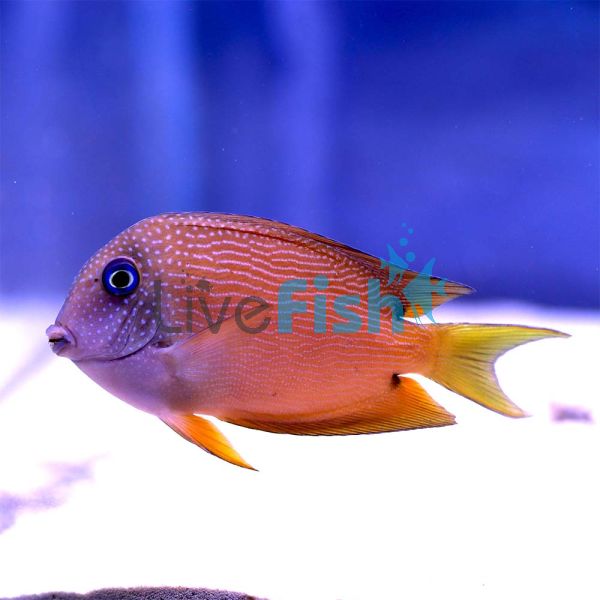Two Spot Bristletooth Tang - Medium
Two Spot Bristletooth Tangs have several distinguishing features. The name comes from the 2 black spots above and below the caudal area. They also have a blue ring around their eye with the same colour running along the top of the dorsal and anal fins. Their body colour is a blend of orange into brown, with paler spots over the face and green/blue lines running down its body. Juveniles have a yellow tail that darkens as they mature. The caudal spines at the base of the tail are used for defence, so handle with care.
Two Spot Bristletooth Tangs
Two Spot Bristletooth Tangs have several distinguishing features. The name comes from the 2 black spots above and below the caudal area. They also have a blue ring around their eye with the same colour running along the top of the dorsal and anal fins. Their body colour is a blend of orange into brown, with paler spots over the face and green/blue lines running down its body. Juveniles have a yellow tail that darkens as they mature. The caudal spines at the base of the tail are used for defence, so handle with care.
There is not much information about this species' breeding patterns. Often spotted in pairs in the wild, the belief is that they spawn this way. Tangs in general are pelagic spawners.
Their natural habitat is across the Indo-Pacific region. Locations include East Africa, Indonesia, Southern Japan, Australia, Hawaii, and Easter Island. They usually inhabit reefs areas, lagoons, and occasionally over rubble substrate. Usually between depths of 3-20 metres, up to a depth of 50 metres.
Tank Recommendations for Two Spot Bristletooth Tangs
Recommended tank size should be at least 70 gallons (265 litres).
Two Spot Brisletooth Tangs can inhabit a reef or fish only tank. They need plenty of places for hiding and shelter in the rock. They are also active, requiring a good size space for swimming.
A tank should be established with algae growth on stones and rocks. This allows them grazing opportunities. If there are insufficient algae, their diet needs extra supplements such as Spirulina.
Suitable Tank Buddies
Two Spot Bristletooth Tangs are generally peaceful but may show hostility to conspecifics. The Ctenochaetus genus is more docile than some other Surgeons. It is better in a more peaceful habitat than with more aggressive fish.
Usually Compatible
Two Spot Bristle Tooth Tangs can cohabit as part of a mated pair. They are best sharing a tank with other peaceful fish. Suitable options include Blennies, Chromis, Dragonets, Pseudochromis and reef safe Wrasse.
Sometime Compatible
Keep an eye on other grazers. There may be competition for the algae your Bristletooth Tang usually consumes. Caution is also advised with Batfish, Foxface's or Rabbitfish.
Rarely Compatible
More aggressive Tangs are not suitable tank buddies. Neither are fish that nip fins. Conspecifics and similar species can show hostility when co-habiting. Seahorses and Pipefish are too delicate to share a tank with Tangs/Surgeons.
Feeding Your Two Spot Bristletooth Tang
Two Spot Bristletooth Tangs are herbivores. They will also consume small crustaceans such as Mysis shrimp and krill. A suitable diet should include a variety of algae, broccoli, spirulina, and zucchini. Dried seaweed such as Nori can be attached to a vegetable clip in an aquarium. Vegetable flake food can also be a good option. Feeding should occur 2-3 times per day.
| Scientific Name | Ctenochaetus Binotatus |
|---|---|
| Care Level | Moderate |
| Common Names | Two Spot Bristletooth Tang, Two Spot Surgeonfish, Blue Eye Bristletooth |
| Diet | Herbivore |
| Fish Family | Acanthuridae |
| Lifespan (years) | 8 |
| Max. Length (cm) | 20 |
| Min. Tank Volume (l) | 265 |
| Origin | East Africa, Indonesia, Southern Japan, Australia, Hawaii, and Easter Island |
| Reef Safe | Yes |
| Sociability | Peaceful |
| Venomous | No |
| Water Conditions | 22.2-25.5° C (72-78° F), dKH 8-12, pH 8.1-8.4, sg 1.020-1.025 |




